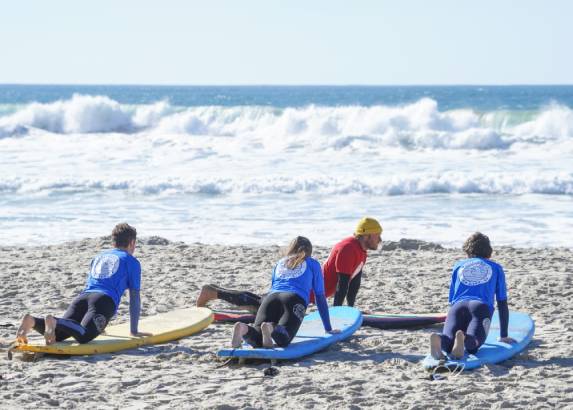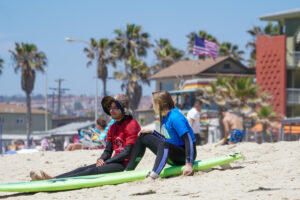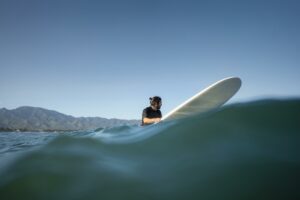Perfect Your Surfing Pop Up Technique
Do you love spending your summer days at the beach? Are watersports the only ones you’ll seek out? If so, you might want to consider learning how to surf. Here, we will detail the steps you’ll need to follow when learning how to pop up on a surfboard.
We will cover the proper stance, how to position your body on a surfboard, and how to balance well. Along with our step-by-step guide, you will learn what to avoid when getting up on a surfboard.
Ready to find out more? Continue reading to learn more about surfing on those huge waves!
Proper Stance
Before you go out and start surfing the waves, you’ll need to learn what type of stance you prefer. You can practice the proper stance right on the beach. Usually, the best way to stand up on the surfboard is to face the side. Yet, you should figure out which stance feels the most comfortable for you.
Generally, your right foot should stand at the back of the board, while your left foot should end up near the center of the surfboard. However, some surfers prefer to switch their legs, so the right foot is towards the front of the board; it’s best to choose the stance that feels more natural for you.
Positioning on a Surfboard
Before you pop up on a surfboard, you must also consider how to position yourself when lying on the board. Our best advice is to put your weight in the middle of the surfboard. Balancing in the middle will allow you to paddle well through the waves while gaining more speed and momentum without sacrificing maneuverability when popping up on the surfboard.
When you start the pop-up position, your feet must remain at the surfboard’s end. Tilt your head forward while keeping your hands flat on the board. Essentially, you’ll need to position most of your body at the end of the surfboard to ensure the waves can lift the board.
Position your feet comfortably for better balance. Below, we cover how to balance effectively on your surfboard.
How To Balance on a Surfboard
To pop up effectively on your surfboard, you must balance well before you try getting up. You’ll need to balance on the board by positioning most of your weight in the middle of the surfboard.
How effectively you pop up will also impact your overall balance on the board. By pushing your upper body up first, you will ensure your surfboard won’t go off balance.
You’ll need to put some pressure on the back of the board, which will ensure the waves won’t throw the surfboard off balance.
Furthermore, the pop-up is as much a feeling as anything else. You’ll need to feel at balance before you can pop up and ride the wave in front of you.
Step-by-Step Guide Detailing How To Pop Up On a Surfboard
Here are the basic steps necessary to follow when learning the proper surfing pop-up technique :
- Paddling
- Getting your body ready for the pop-up position
- Pushing up your chest and upper body
- Moving your back foot forward into a “chicken wing” position
- Hopping up into the pop-up position
- Staying balanced on the surfboard and standing up
You’ll find that you don’t always need to paddle too much, as it can merely tire you out.
Once you see a wave in front, you’ll need to arch your body upwards and get your upper body ready for the pop-up position. Next, keep your hands flat in the middle of the board and use your hands to push your upper body up.
The “chicken wing” position involves sliding your back foot forward and bending and sliding your back knee forward. Have your hands and back foot touch the board before bringing your front foot forward and the front knee toward the chest.
Your other foot should remain shoulder-width with your back foot. Now, when you feel at balance, stand up on the surfboard.
Now that you’re standing up, you may need to shift your weight to gain good balance and ride the wave.
What To Avoid
The main two positions you’ll want to avoid include putting too much of your body weight toward the front of the surfboard and vice versa. You don’t want too much weight on the back of the surfboard, either.
The best option is to have an even amount of weight on both ends and position yourself in the center of the board for better balance.
In fact, if you put more of your body weight toward the front of the surfboard, you’re more likely to nosedive when you finally get up on the board. Too much weight on the back of the surfboard, however, will make it harder to catch waves.
Ready to Perfect Your Pop Up?
Mastering the pop-up technique is crucial to becoming a successful surfer. If you’re interested in perfecting your pop-up and taking your surfing to the next level, consider scheduling a class with Pacific Surf School.
Pacific Surf School offers surfing lessons in some of the most beautiful surfing locations along the Pacific coast, including San Diego, Pacific Beach, Los Angeles, Santa Monica, La Jolla, Manhattan Beach, Mission Beach, and Huntington Beach. With a range of options, you’re sure to find the perfect location to suit your surfing needs.
With our experienced instructors and personalized lessons, we can help you achieve your surfing goals. We offer a variety of options for our lessons such as; private, semi-private, and group surf lessons! Additionally, we also offer surf camps, which provide the perfect opportunity to immerse yourself in the sport and receive personalized instruction from experienced surf coaches.
So don’t wait, take the first step towards your surfing journey today by contacting Pacific Surf School. Our team is ready to help you get started and improve your surfing skills!

FAQs
Read on to learn the most frequently asked questions related to popping up on a surfboard.
- Dry land practice: Start by practicing the motion of your pop up on the beach or on a soft surface. This will help you develop muscle memory and get a feel for the proper technique.
Slow motion: As you practice, try to focus on a slow and smooth pop up. This will help you avoid rushing the motion and ensure that you are using proper form.
Use a foam board: A foam board is a great tool for practicing your pop up because it provides a soft surface and allows you to focus solely on the pop up motion.
Visualization: Visualize yourself popping up on a wave and imagine the sensation of smoothly flowing through the motion. This can help you build confidence and focus your mind on the technique.
Practice with a friend: Practicing with a friend can be a fun and supportive experience. You can help each other perfect your technique and provide encouragement and feedback.
Incorporate pop ups into your surf sessions: When you’re out in the water, make a point to practice your pop ups between waves. This will help you build muscle memory and increase your confidence.
Remember to be patient and persistent with the learning process. Popping up is a fundamental skill in surfing and takes time and practice to master. But with dedication and effort, you’ll be popping up on your surfboard like a pro in no time!
- Timing: Timing is crucial when it comes to popping up. You want to pop up just as the wave is starting to lift you up and carry you forward. This will allow you to get into the right position on your board and start riding the wave.
Speed of the wave: Pay attention to the speed of the wave and how it is building. You want to pop up when the wave is starting to pick up speed and you have enough momentum to get up on your feet and into a riding position.
Wave shape: Observe the shape of the wave and how it is breaking. If the wave is a steep and fast-breaking wave, you’ll need to pop up quickly and be ready to balance immediately. If the wave is a more gradual and rolling wave, you may have a little more time to pop up and get into position.
Your position on the board: Your position on the board is also important when deciding when to pop up. You want to be in the right position on the board so that you can easily pop up and get into a riding stance.
Practice and experience: The more you surf, the better you will get at reading the waves and knowing when to pop up. Practice and experience are key to developing this instinct and making the right decision when it comes to popping up.
Remember that timing and technique are both important when it comes to popping up.
Here are some of the key muscle groups involved in the pop up motion:
Core muscles: Your core muscles, including your abs, obliques, and lower back, play a crucial role in maintaining balance and stability during the pop up.
Quadriceps and hamstrings: Your quadriceps and hamstrings are responsible for extending your legs and helping you push yourself up into a standing position on the board.
Chest and triceps: Your chest and triceps are used to help you push up and forward into a standing position on the board.
Shoulders: Your shoulders are used to help you rotate your body and get into a riding stance on the board.
Glutes: Your glutes play a role in helping you maintain balance and stability during the pop up motion.
It’s important to use these muscle groups in a smooth, coordinated motion in order to execute a successful pop up. It is also equally important to properly stretch these muscles before going out into the water.




